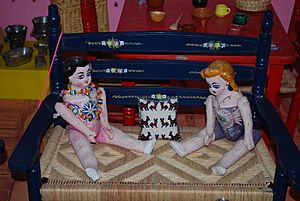Lupita dolls facts for kids
Lupita dolls are special toys from central Mexico. They are made from a very hard type of papier-mâché, a craft called cartonería. These dolls have been around for about 200 years!
Long ago, Lupita dolls were a cheaper choice than fancy porcelain dolls. They were very popular until the mid-1900s, when plastic dolls became common. Today, only a few skilled artists in Celaya, Mexico, still make them. These dolls are now often bought by collectors. Since the 1990s, artists like María Eugenia Chellet and Carolina Esparragoza have worked to bring these dolls back. They get help from the government to keep the old ways of making them alive, but they also create new designs.
Contents
What are Lupita Dolls?
A Lupita doll is a type of papier-mâché doll. Poor families often made them, along with dolls from straw, wood, or cloth. The papier-mâché method, called cartonería, makes the dolls very hard when dry. This same technique is used for other Mexican crafts, like colorful alebrijes and figures for Day of the Dead.
How Lupita Dolls are Made
Artists usually make Lupita dolls using molds. One mold is for the head and body, and others are for the arms and legs. They layer strips of paper and paste very thickly onto these molds. Once the five pieces (head/body, two arms, two legs) are dry, small holes are drilled into them. This allows the parts to be connected.
The arms are joined to the body with a single cord. This cord goes from one upper arm, through the body, and out the other upper arm. You can see small knots on the upper arms. The legs are attached in a similar way. This clever design lets the arms and legs move from the shoulders and hips, just like a real person!
Traditional Look of Lupita Dolls
Traditional Lupita dolls are painted in different skin tones. Other colors are added to look like clothes or underwear. Some old dolls also have beautiful flower designs. These designs come from the Otomi people. Dolls painted with underwear are then dressed in tiny costumes.
Where Lupita Dolls are Known
The art of making Lupita dolls is most famous in Mexico City and in Celaya, Guanajuato. In Celaya, people simply call them "muñecas de carton," which means "cartonería dolls." Artists in Celaya often paint names right on the doll's chest.
These dolls were often played with alongside tiny chairs, tables, and dishes. Even today, you might see them displayed sitting on a miniature chair.
Images for kids




